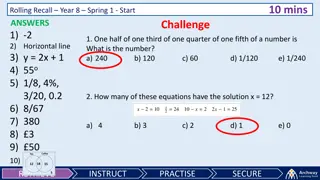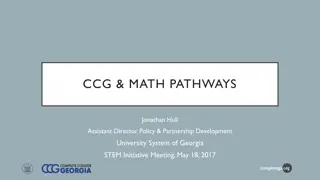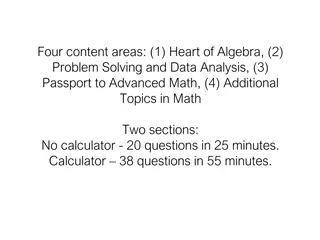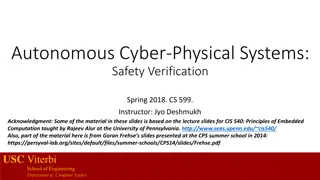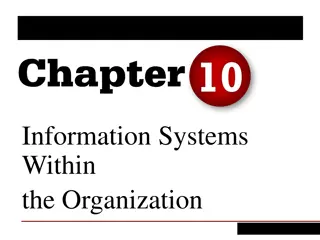Introduction to Dynamical Systems Math 319
Dive into the world of dynamical systems with a focus on applications like population growth, radioactive decay, and more. Learn about discrete time steps, multivariable models, and the essence of dynamical systems in tracking changes over time. Explore the simplicity of Euler's Method and the importance of specifying time steps in models.
Download Presentation

Please find below an Image/Link to download the presentation.
The content on the website is provided AS IS for your information and personal use only. It may not be sold, licensed, or shared on other websites without obtaining consent from the author.If you encounter any issues during the download, it is possible that the publisher has removed the file from their server.
You are allowed to download the files provided on this website for personal or commercial use, subject to the condition that they are used lawfully. All files are the property of their respective owners.
The content on the website is provided AS IS for your information and personal use only. It may not be sold, licensed, or shared on other websites without obtaining consent from the author.
E N D
Presentation Transcript
Introduction to Dynamical Systems Math 319 Prof. Andrew Ross Version: 2015-05-01
Attention Future Teachers! This stuff is: Fairly easy to do Obviously applicable to the real world Good practice with Excel (no add-ins!)
Basic Applications we will see Population growth Savings account growth Radioactive Decay Single dose of medicine
Slightly Fancier Applications Credit Card/Mortgage/Rent-To-Own Saving A Little Each Year Repeated medicine dosing Newton s Law of Cooling (and heating) Even fancier: Population growth with an upper limit
Multivariable models Rental car tracking Google PageRank Population growth with age categories Pharmacokinetic Compartments Spread of an epidemic Predator vs. prey populations Multi-region models
What is a Dynamical System? Something that changes in time. Review the applications we just mentioned do they all involve tracking something in time? We will consider only discrete time steps. If you want continuous time, take a class in Differential Equations. Our way is easier! Our way is basically Euler s Method, the simplest (but not so accurate) way to discretize a DiffEq. Better ways: Runge-Kutta, various stiff solvers
Discrete Time? sometimes a better match for reality than continuous time especially when things happen e.g. once-a-month instead of continuously. sometimes better when there's a known cycle we want to ignore, like daily, weekly, or yearly/seasonal. not like business cycles length isn t certain.
Specify your time steps! second, minute, 5-minute, hour, day, week, month, year, decade, century, ??? Usually want all time steps in one model to be the same size e.g. not "from one hurricane to the next"
Notation Subscript n indexes the time steps The variable we re tracking is written generically as a instead of y Different authors do different things. So instead of f(t) or f(x) we have an Or a_n if we are lazy about writing subscripts. Other people argue that a is a function, so we should still write it as a(n) instead of a_n
Direct vs Recursive Formulas Instead of giving a direct formula like a_n = n^2/ (2n)! We define our model via the change from one time to the next. delta a_n = a_(n+1) - a_n So if we know a_n and delta a_n, we can compute: a_(n+1) = a_n + delta a_n
Specify the Change Most of our models will be given as: delta a_n = (some function of a_n) Along with an initial value for a_0 Sometimes it will be delta a_n = (some function of n and a_n)
Savings account, 1% interest per year Time step size of 1 year Let a_n be the balance at the start of year n. a_0 = $1000 delta a_n = 0.01 * a_n We have now completely defined our model. TimeStep Balance delta 0 $1000 $10 1 $1010 $10.10
Population Growth The US is growing at about 1% per year. Time step size of 1 year Let a_n be the population in millions at the start of year n. a_0 = 300 delta a_n = 0.01 * a_n We have now completely defined our model. Notice any similarity to the previous model?
Radioactive Decay Carbon-14: after 100 years, lost 1.2% or so Time step size of 1 century Let a_n be the amount in micrograms at the start of time step n. a_0 = 10 delta a_n = -0.012 * a_n We have now completely defined our model.
Single dose of a medicine Tylenol: 15.9% lost from body every hour. Time steps of 1 hour Let a_n be the amount in milligrams at the start of time step n a_0 = 500 delta a_n = -0.159 a_n This general field is pharmacokinetics or pharmacodynamics We re ignoring the initial buildup for now.
Mortgage About 0.5% interest charged each month Then subtract your (constant) monthly payment Time step size of 1 month a_n is your balance at the start of month n delta a_n = +0.005 * a_n - $800
Credit cards If you stop charging more on them, they work mostly like a mortgage Typical interest of 24%/year (about 2%/month) instead of 6%/year Minimum payment is not constant, but you could make constant payments if you want.
Saving A Little Each Year Add $1000 to your savings each year Start with a steady 2% growth Fancier: use returns from the Dow Jones as the interest rate
Repeated Dosing Suppose I take 300mg of Tylenol every 6 hrs. Let the time step size be 6 hours Let a_n be the amount (mg) in my system immediately after taking a dose. a_0 = 300 Note: I am not a medical doctor. Consult your physician as necessary. Recall: lose 15.9% per hour
Which equation wont poison you? 1) delta a_n = -(0.159^6)a_n + 300 2) delta a_n = -(1-(1-0.159)^6)a_n + 300 3) delta a_n = -(1-0.159^6)a_n + 300 4) delta a_n = -(1-0.159)^6 a_n + 300
Newtons Law of Cooling An object that is warmer or cooler than the ambient temperature Temperature change is proportional to the difference in temperatures (ambient minus object temp) Constant of proportionality is actually hard to determine experimentally. Data slides at end of this file
More Newton cooling/warming Time step size of 1 minute Let a_n be the temp (deg. F) of the object Ambient temp of 350 F. a_0 = 40 delta a_n = k*(350 - a_n) Do the signs (+/-) make sense? What starts at 40 deg. F in an ambient temp of 350 deg F? What if k is too large in this example?
Which freezes faster? Hot water or cold water? Sadly, too many other variables to consider: Evaporation Causes cooling Causes less water to try to freeze Dissolved gasses Freezer on/off cycles Air currents in freezer
Limited Population Growth C = Carrying Capacity (max sustainable size of population) Time step size: depends on context Growth is proportional to: Current population size (like ordinary growth) Distance to C (small distance to C gives small growth) Some people do: delta a_n = k1* a_n * (C - a_n) But it s better to do delta a_n = k * a_n * (1 - a_n/C)
Logistic Growth data set users.humboldt.edu/tpayer/Math-115/Expo_86.doc The First Laboratory Experiment of Population: Measuring the Population Growth of Brewers' Yeast. In 1913, the Swedish biologist Tor Carlson conducted the first laboratory controlled experiment where the growth of a biological population was measured and recorded in hourly time intervals. His subject was Saccharomyces Cerevisiae, better known as brewer s yeast and a sample of his data is given
Real data Time(hours) Biomass 0 1 2 3 4 5 6 7 8 9 10 11 12 13 14 15 16 17 18 9.7 18.3 29 47.2 71.1 119.1 174.6 257.3 350.7 441 513.3 559.7 594.8 629.4 640.8 651.1 655.9 659.6 661.8 The textbook by Giordano et al. has this on page 11, and eyeballs the carrying capacity at [everybody, please quietly write down your own eyeball estimate of the carrying capacity! 665].
Time Scales/Discrete to Continuous What if we re currently modeling year-to-year, but want to change to month-to-month? First idea: keep the delta equation the same, but use a_(month n+1) = a_n + (delta a_n)*1/12 Does it give the same results? Let time step go to zero, get Differential Equation
Potential Quiz: Single-Variable Models Model Delta equation Sketch (horiz=time, vert=a_n) Compound Interest / Unlimited Pop. Growth delta a_n = Radioactive Decay / Single dose decay delta a_n = Mortgage, Credit Card, Student Loan delta a_n = Saving A Little Each Year delta a_n = Repeated Dosing delta a_n = Cooling/Warming delta a_n = Limited Pop. Growth delta a_n =
Multivariable models Rental car tracking Google PageRank Population growth with age categories Pharmacokinetic Compartments Spread of an epidemic Predator vs. prey populations
Rental Car tracking 100 cars; each is either Here or Rented Time step size: one day Let H_n = # cars Here at opening on day n, Let R_n = # cars Out at opening on day n. 60% of cars that are Here today will still be Here tomorrow 30% of cars that are Rented today will be Here tomorrow Other applications?
Will find tomorrows values directly rather than via delta H_(n+1) = 0.6 * H_n + 0.3 * R_n R_(n+1) = ??? * H_n + ??? * R_n Let y_n = [H, R]_n (a row vector) Let matrix A = 0.6 ??? 0.3 ??? Then y_(n+1) = y_n * A In Excel, use =MMULT( y range, A matrix range )
Using MMULT: Array formula MMULT gives back more than a single value: it gives back a whole vector or matrix. Start by highlighting the cells (not just 1 cell!) where you want the result to go. Then type =mmult(first matrix range, 2ndmatrix range) BUT DON T PRESS ENTER! Instead of pressing Enter, hold down Control and Shift, then press Enter. If you make a mistake, you have to re-do the whole array formula; can t change just a part of it.
Complications Here, Rented, or in Maintenance Different prob. of return based on how many days it has been rented so far Different types of car Different probabilities for Friday vs Saturday, etc. Different probabilities for March vs. August, etc. One-way rentals
Google PageRank How important is each web page? Can t just count inbound links Vulnerable to link farms http://en.wikipedia.org/wiki/Pagerank The 25 Billion Dollar Eigenvector Google indexes somewhere around 60 billion web pages, out of 1 trillion URLs.
Population growth with age categories Suppose squirrels live 4 years at most. a 0.8 chance of going from 0 years old to 1 yr old a 0.7 chance of going from 1 years old to 2 yr old a 0.4 chance of going from 2 years old to 3 yr old a 0.1 chance of going from 3 years old to 4 yr old To 0 To 1 To 2 To 3 To 4 From 0 From 1 From 2 From 3 From 4
Fertility A 0-yr-old squirrel generates 0 offspring A 1-yr-old squirrel generates 1.7 offspring A 2-yr-old squirrel generates 1.4 offspring An age 3 or 4 squirrel generates 0 offspring To 0 To 1 To 2 To 3 To 4 From 0 From 1 From 2 From 3 From 4
Population Dynamics x_(n+1) = x_n * A Leslie matrix Sometimes matrix A is written with from on the columns and to on the rows (e.g. the Wikipedia page: Leslie matrix) Fun related video: Hans Rosling s talk Religions and Babies http://www.ted.com/talks/hans_rosling_religions_and_babies.html
Pharmacokinetic Compartments Simplistic model: As medicine leaves the stomach, it enters the gut, then bloodstream, then the lymph, then decayed. Simple model: 10% movement each time step Start with 500 mg in stomach Gamma distribution curves Real models: different % for each type of movement Sum-of-exponentials Neurons: Hodgkin-Huxley or FitzHugh Nagumo
Outrageous Price on Amazon Amazon s $23,698,655.93 book about flies By MICHAEL EISEN | Published: APRIL 22, 2011 A few weeks ago a postdoc in my lab logged on to Amazon to buy the lab an extra copy of Peter Lawrence s The Making of a Fly a classic work in developmental biology that we and most other Drosophila developmental biologists consult regularly. The book, published in 1992, is out of print. But Amazon listed 17 copies for sale: 15 used from $35.54, and 2 new from $1,730,045.91 (+$3.99 shipping). Day of April: Seller1 Seller2 8 $ 1,730,045.91 $ 2,198,177.95 9 $ 2,194,441.05 $ 2,788,234.85 10 $ 2,783,494.85 $ 3,536,680.72 11 $ 3,530,668.37 $ 4,486,031.92 12 $ 4,478,405.66 $ 5,690,217.45 13 $ 5,680,544.08 $ 7,217,642.51
Spread of a Disease Classify people as Susceptible, Infected, Removed = SIR Model (Kermack-McKendrick model) Removed: either Cured & immune, or Dead (& immune, we hope!) Main approximation: # newly infected is Directly proportional to # susceptible Directly proportional to # currently infected Only way to do this is: # new infec. = k*S*I Also approximate: 45% of Infected recover or die each time period. We don t do the live in-class demo of this, after what happened last year. Cough cough.
SIR equations Time step: 1 week could range from a day to a year, depending on the disease delta S_n = - k*S_n*I_n delta I_n = + k*S_n*I_n 0.45*I_n delta R_n = + 0.45*I_n TimeStep S I R Newinfection NewRemoved 0 99 1 0 K*S*I 0.45*I 1 prevS-NewInf prevI+newInf- newRemoved prevR + newRemoved Like above Like above
Extensions Vaccinations move people from S to R skipping I (mostly) Some diseases have no immunity: Susceptible- Infected-Susceptible again (SIS model) Transmissibility changes by time of year Phases of being Infected: contagious but unaware (SIER model) sick but not yet contagious (SEIR) Malaria: humans & mosquitoes Ross-Macdonald model, 1911/1957 Immigration, Emigration, births, non-disease deaths
Predator vs. Prey Canada: lynx and hare Isle Royal, MI: Moose and wolves http://en.wikipedia.org/wiki/Lotka%E2%80%93Volterra_equation
Predator-Prey equations Predator w_n = # of wolves in year n Prey m_n = # of moose in year n delta w_n = k1 * w_n k1 < 0 : if no moose, wolves starve. Interactions: o Directly proportional to # of each species? o Interactions are good for wolves: k3>0 delta m_n = k2 * m_n k2 > 0 : if no wolves, moose thrive. Interactions: o Directly proportional to # of each species? o Interactions are bad for moose: k4<0 delta w_n = k1 * w_n + k3 * w_n * m_n delta m_n = k2* m_n + k4 * w_n * m_n
Extensions Other relationships: Competitive Hunters: hawks and owls Symbiosis: bees and flowers Carrying capacity other than predator effect 3rd, 4th, etc. species Harvesting policies Relationship to chemical clocks Project idea: estimating the coefficients from data (real data=hard, artificial data=easier)
Dynamical Systems In Space We started simple, with only one geographic region for our SIR or predator/prey model Could have multiple adjoining regions One-dimensional: Chile or Baja California Two-dimensional: almost everything else Three-dimensional: rain forest, atmosphere, oceans, groundwater, or inside a person s body. Can also model the spread of a pollutant, or heat, or invasive species Countercurrent Flow?
Our next topics Generalizing from what we have seen: Equilibrium (steady-state) vs. transient Stable and unstable equilibria Linear vs nonlinear systems Fun stuff Chaos Detailed repeated dosing using modulo
Seasonal Inputs Why is noon not the hottest time of day, even though solar input is highest at noon? Why is the summer solstice not the hottest day of the year, even though solar input is highest then?
Varying Heat input by season: Let day 0 be Dec 21st. External ambient temperature of = - COS(2*PI()* day# /365)*30+50 Heat transfer coefficient of 0.01 Initial temperature of 35
This model applies to: hourly temperature changes during the day yearly temperature changes electricity in a resistor/capacitor circuit low-pass filter queueing systems with time-of-day input car suspension systems (spring & shock absorber) Try changing the frequency: use 8*2*pi() instead of just 2*pi()








